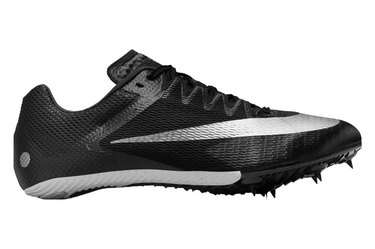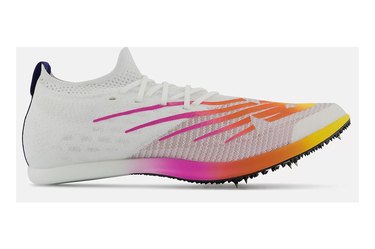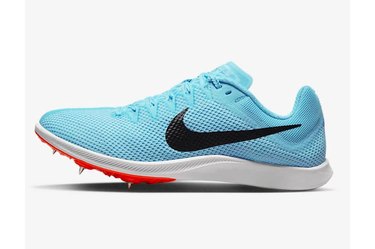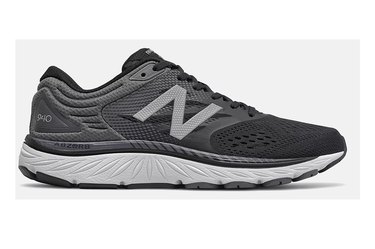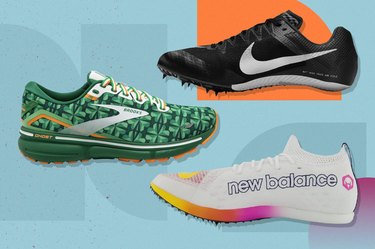
For runners of all ages and experience levels, getting a little experience on the track can be a fun way to shake up your routine. After all, you don't need to be a collegiate athlete to hone your sprinting skills.
And while you can use regular running shoes to train on a track, you may want to invest in a pair of track shoes (aka track spikes) if you decide to compete or want a better estimate of your race time.
Video of the Day
Video of the Day
Read on to learn the difference between track spikes versus running shoes, plus how to find the best pair for your miles.
What’s the Difference Between Track Spikes and Running Shoes?
If you're comparing track shoes versus running shoes, track spikes are lighter, more minimal shoes that often have a cleat or spike in the forefoot to give you some extra traction as you push off the ground during a race, according to Janet Hamilton, CSCS, a clinical exercise physiologist and owner of Running Strong.
The best shoes for track also often have minimal heel cushioning, as most track runners tend to spend a majority of contact time on their forefoot, she says. In other words, they run on the front of their foot, rather than striking with their heel. So, track spikes are designed for that type of foot strike.
On the other hand, running shoes are the sneakers you see at most athletic apparel stores. These are more cushioned to help minimize the impact to your joints, making them ideal for longer-distance running, rather than a few speedy loops around a track.
Running sneakers offer more stability than spikes and are generally the type of shoes you'll want to get if you're not competing on an actual track.
How We Chose
We chatted with running experts and coaches to learn about all the best track spikes and running shoes. From there, we gathered a few great track spikes and running shoes you'll want to consider. Every pair takes the following criteria into account:
- Price
- Quality
- Materials
- Comfort
Why Are Certain Shoes Marketed to Men or Women?
We make deliberate choices about the language we use, but most manufacturers typically market shoes according to gender, so we have listed both women's and men's picks below according to the language used by the brands.
However, there is very little difference between women’s and men’s spikes. Men’s shoes are typically wider, so if you have narrow feet, it’s best to stay away from men’s and unisex spikes. We encourage everyone to shop according to their personal preferences rather than feel restricted by marketing lingo.
Best Track Spikes
1. Best for Short Sprints: Nike Zoom Rival Sprint Track and Field Shoes
One of the best running shoes for track, these are built for fast, short track races, ranging from the 60-meter dash to the 400-meter sprint. But for athletes who compete in multiple events, these can also be used for hurdles, the long jump or pole vault.
These have steel spikes that are safe for all surfaces and offer plenty of traction, promising you safety as you brake.
Buy it: DicksSportingGoods.com; Price: $69.99
2. Best for Mid-Distance Races: New Balance FuelCell MD-X
These lightweight New Balance spikes are one of the best shoes for track when it comes to middle-distances races. They have a little extra foam in the heel to help propel you forward and offer a little extra joint protection during races.
The knit upper on these spikes feels snug and stable and with the lace closure, you won't have to worry about losing a shoe mid-race.
Buy it: NewBalance.com; Price: $159.99
3. Best for Long-Distance Races: Nike Zoom Rival
For longer races, the Nike Zoom Rival is the track shoe you want in your arsenal. These spikes have extra cushion in the heel and mid-foot for more comfort during longer races — but they're still super light on your feet, making them good track shoes.
They have a single-layer mesh upper for extra breathability in warm weather. They also have four adjustable spikes on the bottom.
Buy it: Nike.com; Price: $70
Best Running Shoes
4. Best for New Runners: Brooks Ghost 15
Brooks shoes are a fan-favorite in running communities — and for good reason: The company focuses solely on running shoes and gear.
The Ghosts are a great pick for new runners, as they're cushioned and work well on all surfaces, including dirt paths and treadmills. These are also available in several widths, so you can easily find your perfect fit.
Buy it: Brooksrunning.com (men's); Brooksrunning.com (women's); Price: $140
5. Best for Treadmill Running: Asics GEL-NIMBUS 24
This Asics shoe has plenty of cushion and breathable fabric, which is exactly what you want when indoor runs get too steamy.
Unlike many other running shoes, these also have a gender-specific design in the forefoot due to the minimal differences in men's and women's feet. So, make sure to buy the product that's appropriate for you.
6. Best for Extra Stability: New Balance 940v4
New Balance's walking and running shoes are among the best options for ankle support.
These shoes are built for stability, thanks to the highly cushioned (and shock absorbing) sole. The mesh upper offers compression to help keep your foot and ankle safely locked in place, too.
Buy it: NewBalance.com (men's); NewBalance.com (women's); Price: $139.99
What to Know Before Buying Track and Running Shoes
1. Find Your Perfect Fit
For both running shoes and spikes, fit is crucial — buy a shoe that's too wide or large for your feet and it's a rolled ankle waiting to happen. Running spikes feel pretty different from shoe to shoe, which is why trying them on is extra important.
But the same goes for running shoes. For one, you want to make sure the toe box feels comfortable without being too wide or narrow, according to Adina Crawford, a Road Runners Club of America (RRCA) certified run coach and ambassador for Black Girls Run.
For the most part, track shoes don't have too much cushion, as Hamilton mentioned, but you do want to look for a little extra support for longer-distance races. After all, running on a completely flat shoe for a mile or two can get uncomfortable.
Cushion matters for your running trainers, too, Crawford says. The cushioned soles help protect your joints from the impact of repeatedly striking the ground. And while the feel is a matter of personal preference, you should look for extra cushion for longer distances.
2. Know Your Spike Length
As a former high school and collegiate runner, I can confirm that the actual spikes on the bottom of your shoes matter. Although cross-country spikes and track shoes are different, they both have small metal spikes on the bottom.
Track meets generally have regulations that dictate how long the spikes on the bottom of your shoe can be (usually a 9-millimeter max). This is to help prevent damage to the track during a race. So, it's best to check with your race organizers to make sure your spikes are appropriate.
3. Look for Traction
No matter if you're running around a track or on pavement, traction is a must-have, according to Crawford. Your track shoes or standard running sneakers should feel safe and stable on all surfaces to prevent slips and falls.
Most shoe companies have pretty lenient return policies, so you can test several pairs right at home. Order a few different brands and models and take them for a quick jog around the block to make sure they grip the ground properly.
And for runners looking to take their workouts onto uneven paths, browse a few trail running shoes. These have raised lugs on the bottom to provide extra traction on rocky or muddy surfaces.
